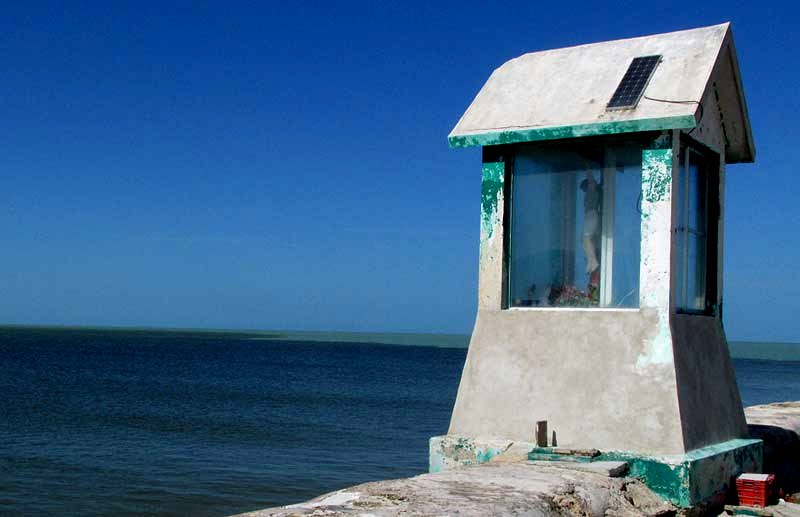
An Excerpt from Jim Conrad's
NATURALIST NEWSLETTER
December
28, 2014
Issued
from Río Lagartos on the north-central coast of Yucatán, MÉXICO

In front of Río Lagartos, directly north of town across Ría Lagartos Estuary, a manmade canal cuts through the narrow finger of land separating the estuary from the Gulf of Mexico. At one edge of the canal's seaward outlet there's a seawall topped with a Jesus-on-the-Cross fisherman's chapel lighted at nights with solar power stored in a battery, as shown above. Beyond the chapel, notice how the Gulf's water changes color. The dark blue water on the left is issuing from the estuary during ebb tide -- when the water is going down.
Inside the estuary, water issuing from the mangrove forests typically is dark amber colored, as shown at the bottom of our Mangrove Page at http://www.backyardnature.net/yucatan/mangrov2.htm.
The water's darkness is caused by orangish tannin pigments derived from decomposing organic matter in the mangrove area, and from organic matter itself suspended in the water. Mangrove trees are especially rich in tannins.
These tannin- and organic-matter-rich waters are profoundly important to offshore biological communities, especially the corals. As Lucaya Luckey-Bethany writes in the paper "Mangrove Forest Decline and its Effect on Coral Reefs," "The destruction of mangrove forests in the coastal wetlands is drastically decreasing the amount of natural tannins in the water and thus subjecting the nearby coral reefs to undue UV radiation. In effect, the reefs are being sunburned and eventually coral bleaching occurs." This paper is freely available online here.
Therefore, when fishermen exit the canal on their way to unknown fortunes on the high sea, they may tip their hats to Jesus on his Cross in his solar powered chapel, but it would also be appropriate to show their respect for the dark water below them, which assures the productivity of the fisheries they're going out to exploit.
Its water dark with organic matter and tannins -- not to mention zooplankton, phytoplankton and immature organisms that have used the mangroves as a nursery -- is the very lifeblood of the offshore ecosystems they depend on.